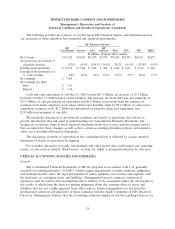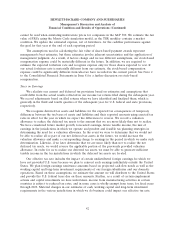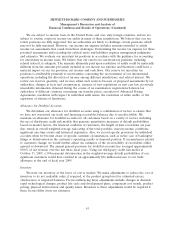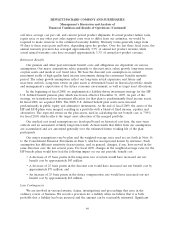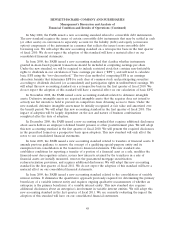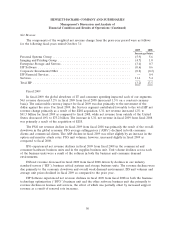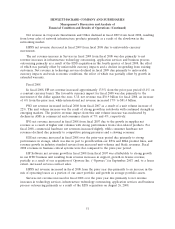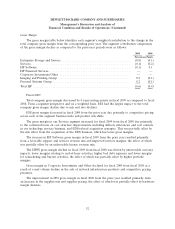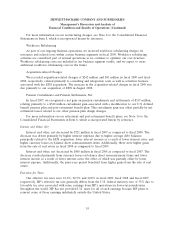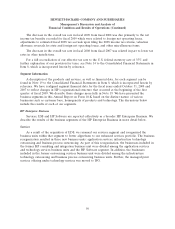HP 2009 Annual Report Download - page 55
Download and view the complete annual report
Please find page 55 of the 2009 HP annual report below. You can navigate through the pages in the report by either clicking on the pages listed below, or by using the keyword search tool below to find specific information within the annual report.HEWLETT-PACKARD COMPANY AND SUBSIDIARIES
Management’s Discussion and Analysis of
Financial Condition and Results of Operations (Continued)
In May 2008, the FASB issued a new accounting standard related to convertible debt instruments.
The new standard requires the issuer of certain convertible debt instruments that may be settled in cash
(or other assets) on conversion to separately account for the liability (debt) and equity (conversion
option) components of the instrument in a manner that reflects the issuer’s non-convertible debt
borrowing rate. We will adopt this new accounting standard on a retrospective basis in the first quarter
of fiscal 2010. We do not expect the adoption of this standard will have a material effect on our
consolidated financial statements.
In June 2008, the FASB issued a new accounting standard that clarifies whether instruments
granted in share-based payment transactions should be included in computing earnings per share.
Under the new standard, we will be required to include restricted stock that contains non-forfeitable
rights to dividends in our calculation of basic earnings per share (‘‘EPS’’), and will need to calculate
basic EPS using the ‘‘two-class method.’’ The two-class method of computing EPS is an earnings
allocation formula that determines EPS for each class of common stock and participating securities
according to dividends declared (or accumulated) and participation rights in undistributed earnings. We
will adopt this new accounting standard on a retrospective basis in the first quarter of fiscal 2010. We
do not expect the adoption of this standard will have a material effect on our calculation of basic EPS.
In November 2008, the FASB issued a new accounting standard related to defensive intangible
assets. Defensive intangible assets are acquired intangible assets that the acquirer does not intend to
actively use but intends to hold to prevent its competitors from obtaining access to them. Under the
new standard, defensive intangible assets must be initially recognized at fair value and amortized over
the benefit period. We will adopt this new accounting standard in the first quarter of fiscal 2010. The
impact of adoption will be largely dependent on the size and nature of business combinations
completed after the date of adoption.
In December 2008, the FASB issued a new accounting standard that requires additional disclosures
about assets held in an employer’s defined benefit pension or other postretirement plan. We will adopt
this new accounting standard in the first quarter of fiscal 2010. We will present the required disclosures
in the prescribed format on a prospective basis upon adoption. This new standard will only affect the
notes to our consolidated financial statements.
In June 2009, the FASB issued a new accounting standard related to transfers of financial assets. It
amends previous guidance to remove the concept of a qualifying special-purpose entity and its
exemption from consolidation in the transferor’s financial statements. This new standard also
establishes conditions for reporting a transfer of a portion of a financial asset as a sale, modifies the
financial-asset derecognition criteria, revises how interests retained by the transferor in a sale of
financial assets are initially measured, removes the guaranteed mortgage securitization
recharacterization provisions, and requires additional disclosures. We will adopt this new accounting
standard in the first quarter of fiscal 2011. We do not expect the adoption of this standard will have a
material effect on our consolidated financial statements.
In June 2009, the FASB issued a new accounting standard related to the consolidation of variable
interest entities. It eliminates the quantitative approach previously required for determining the primary
beneficiary of a variable interest entity and requires ongoing qualitative reassessments of whether an
enterprise is the primary beneficiary of a variable interest entity. This new standard also requires
additional disclosures about an enterprise’s involvement in variable interest entities. We will adopt this
new accounting standard in the first quarter of fiscal 2011. We are currently evaluating the impact the
adoption of this standard will have on our consolidated financial statements.
48


